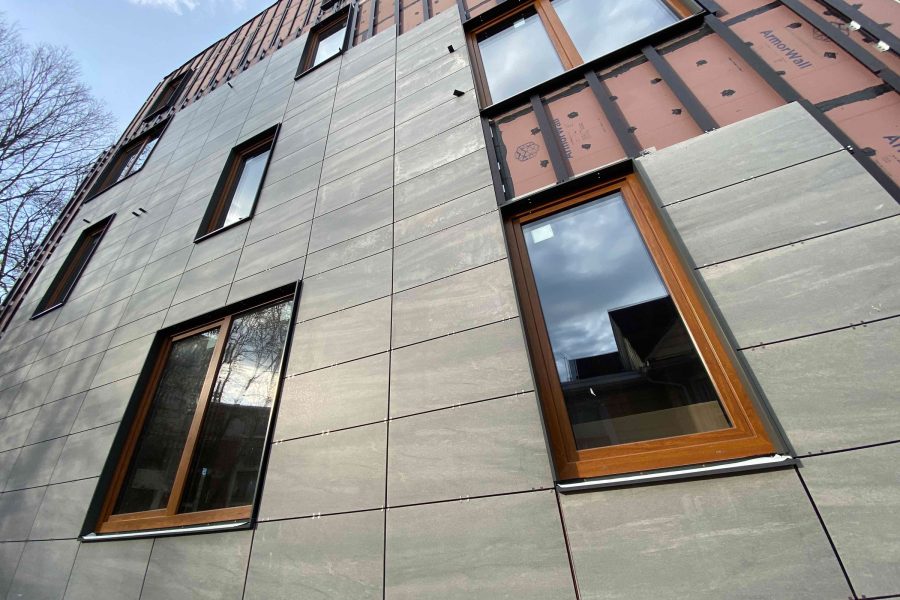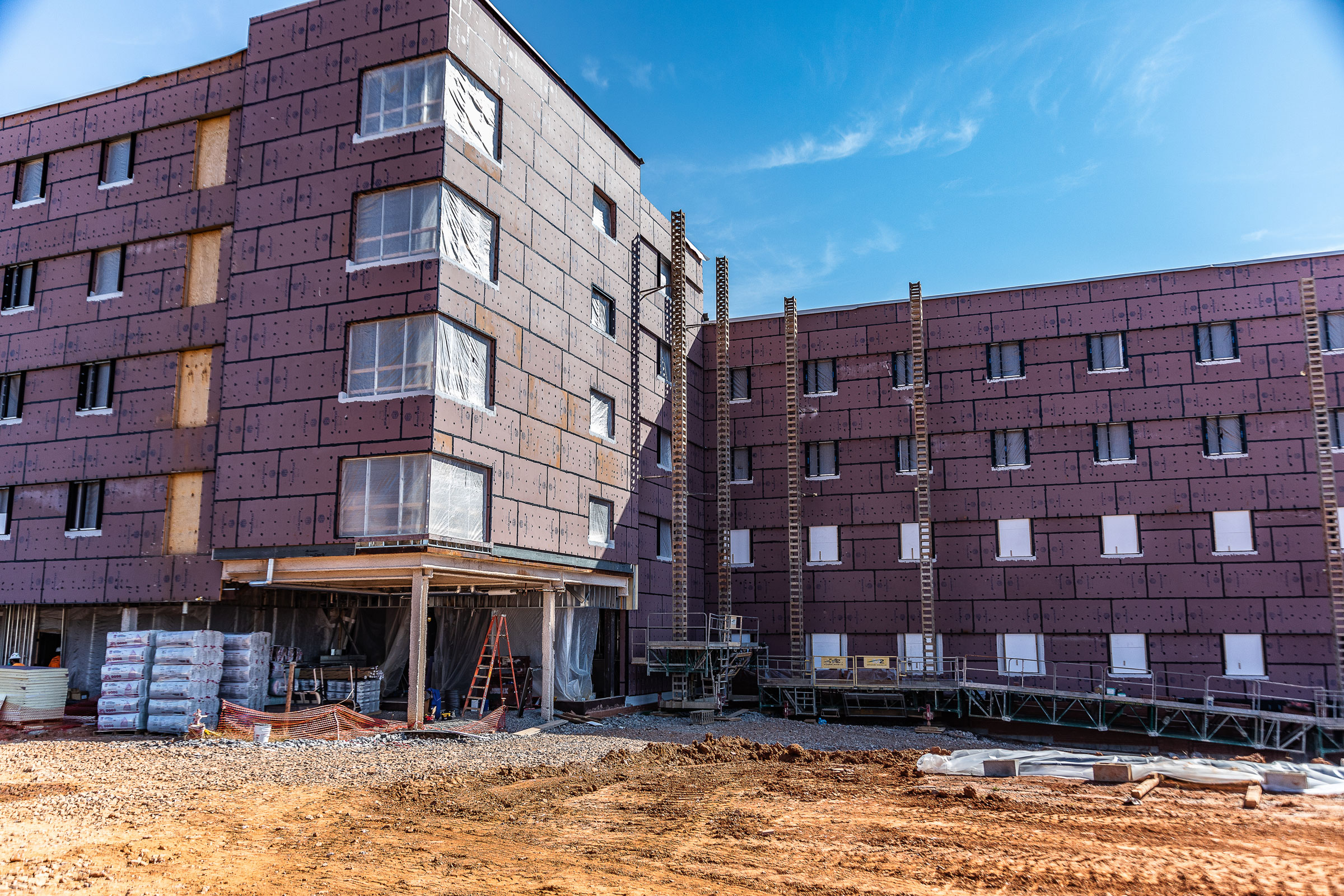Story at a glance:
- Skanska Sustainability Director Elsa Mullin says an early, holistic design approach is necessary to achieve high-performing buildings.
- Exterior building systems in particular include many considerations that must be carefully thought through for optimal building and energy performance.
- DuPont’s five-in-one ArmorWall assembly system improves efficiency across the construction process.
In the built environment the success of a building is determined by its performance. Yes, aesthetics are important, but if a structure doesn’t live up to the building intent, then it has failed.
In the past “building performance” has been a generic phrase used throughout the built environment for how well each element of a building works together. But in today’s data-driven world, building performance is evolving, transforming how we construct and design buildings along with it—especially when it comes to efficiency.
“The whole building industry is advancing, which means that every design and operations element needs to be considered for overall performance and energy efficiency,” says Elsa Mullin, sustainability director at Skanska. “We’re no longer just looking at operational energy or operational carbon anymore. We’re also looking at embodied carbon and things that otherwise are harmful to human and environmental health.”
Every design and operations element needs to be considered for overall performance and energy efficiency.
For exterior walls, in particular, a multitude of considerations must be carefully considered to achieve optimal building and energy performance. And they go far beyond the traditional codes and measures the industry typically thinks of.
“We have to go above just the typical MEP systems, standard R-value, and thermal performance,” Mullin says. “Now we have even more attention and focus on how important air tightness is and also making sure we’re not over-insulating or under-insulating a wall. Designing for resilience is extremely important, too.”
To meet modern standards for building performance, Mullin says building disciplines must come together ready to collaborate as early as possible on a project. “With all of these considerations now, you need a holistic approach really early on,” she says. “It really takes a team willing to dig in early and vet different design solutions and different materials to get there.”
Bringing Efficiency to Exterior Building Systems

Photo courtesy of DuPont Performance Building Solutions
Needless to say, there is a lot of pressure on the building envelope to make buildings efficient, resilient, and safe for occupants. The team at DuPont is working to find the balance between meeting—and exceeding—those requirements and innovating solutions that ease installation, reduce costs, and, ultimately, create better, high-performing buildings.
“Given the growth of continuous exterior insulation, architects face a real challenge when it comes to exterior wall design,” says Chip Bisignaro, national account manager at DuPont. “They’ve got to balance energy needs and are required to provide a system that is not only energy-efficient but at its core is fire-resistant and meets code. It can get very complicated.”
Of the many fruits of DuPont’s labors, the DuPont™ ArmorWall™ System is a standout. The system consolidates five traditional building enclosure elements into one: structural sheathing for direct cladding attachment, fire resistance, air barrier, water-resistive barrier, and continuous insulation.
“It’s a five-in-one solution. It takes applications on the exterior wall—as far as solutions that provide insulation, air and water barriers, and structural sheathing—and combines them into a single product,” says Casey Sincavage, DuPont North America ArmorWall growth manager. “It can be installed quicker than doing each layer individually, as is done in a traditional wall assembly, while also adding the value of being able to attach cladding directly to the ArmorWall System. It’s about building more efficiently with a single solution that achieves more.”
In a way ArmorWall works as a blank canvas, Bisignaro says. “Architects may want to use a certain cladding product or products, but it adds cost because of the complicated structural design needed for the cladding installation. With a product like ArmorWall, you’re essentially creating a canvas that you can directly attach these cladding systems to.”
You’re essentially creating a canvas that you can directly attach these cladding systems to.
Of course, essential building elements like cladding attachment, air barriers, water-resistive barriers, and insulation are not new. But DuPont’s holistic view on creating a solution that puts these individual elements at work together is innovative. ArmorWall is perhaps a prime example of how manufacturers are putting Mullin’s whole-building approach to building performance into practice, finding ways to work together early and efficiently before breaking ground.
“The materials themselves have been around for a long time, but the idea of combining them into a multi-layer material serving multiple purposes to speed up the construction process is relatively new,” Bisignaro says. New—and an offering that can bring efficiency and performance to the construction process itself.
“Years ago continuous exterior insulation, or ci, was not a major part of commercial wall designs. Architects are now adding ci regularly to their designs to meet growing energy code requirements, so that’s another contractor and another schedule for general contractors to account for. Not only that, but you need to install sub-girt assemblies to span the depth of that insulation to handle your cladding loads, which adds another whole step to the construction process,” Bisignaro says. “What we at DuPont try to do is say, despite having all these requirements, a multi-layered performing material like ArmorWall can help eliminate steps without sacrificing quality. There are less subcontractors and less construction schedules for a GC to manage.” And he says owners can begin generating revenue earlier because buildings can be built faster.
Sincavage agrees. “By consolidating products to be installed separately, you reduce labor and reduce costs. It’s about reducing labor and requiring less materials from different manufacturers to achieve the same thing or more, because we’re adding the capability of direct cladding attachments without fastening back to studs. Before it would take maybe four trades to install the exterior wall detail. Now you may only need one to two with this wall system,” he says.
From a sustainability standpoint ArmorWall offers a reduction of onsite waste generation since weather-resistive barriers and insulation, for instance, are now installed together. It’s also GreenCircle Certified and eligible for LEED credits. The ArmorWall System is ideal for incorporation into advanced energy enclosure designs—like passive design, stretch codes, and LEED—due to the limited thermal bridging of the system significantly increasing the effective thermal resistance when considering the impact of fastener and cladding attachments.
When it comes to performance—because it does always come down to performance—the insulation layer of the ArmorWall System has a high R-value of 6.5 per inch.
Manufacturers like DuPont are strategizing how to sustainably innovate solutions that push the built environment further, not only to make architects’ and contractors’ jobs easier but to help ensure the buildings we live, work, relax, and play in are working in our—and the environment’s—favor.


